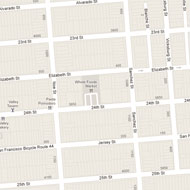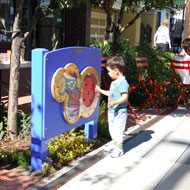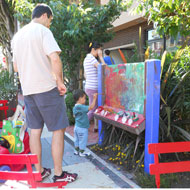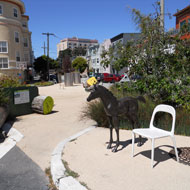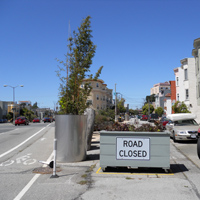
Background
“San Francisco’s streets and public rights-of-way make up fully 25% of the city’s land area, more space even than is found in all of the city’s parks. Many of our streets are excessively wide and contain large zones of wasted space, especially at intersections. San Francisco’s new Pavement to Parks projects seek to temporarily reclaim these unused swathes and quickly and inexpensively turn them into new public plazas and parks.”
From: Pavement to Parks (http://sfpavementtoparks.sfplanning.org/index.htm)
Implementation and Design Concepts
Interview with Andres Power, San Francisco Planning Department, Urban Design Group, P2P Project Manager
- The project was inspired by a visit from NYC Transportation Commissioner, Janette Sadik-Khan, who had successfully implemented a similar program in NYC, including the Times Square pedestrian plaza. She met with department heads in various San Francisco city offices and the mayor. Her vision proved inspirational to city officials.
- Currently there are two different park types:
- Parklets
- The first parklets installed were done by the city. Beginning in September 2010, the city began accepting RFP’s for community-led parklet installation. The city would no longer be installing (or funding) parklets and would instead rely on the community to take initiative. The city did, however, issue permits and design guidelines for any proposed parklets.
- Approximately 25 parklets were permitted in the first RFP round in late 2010.
- Parklets were installed in parking lanes where there was capacity.
- Those organizations submitting proposals were responsible for designing their own parklet space. They were generally allowed wide range as far as design and type of activities are concerned–within reason.
- Applicants were encouraged to hone community support before they applied. If they met design criteria, a public notice was posted at the site. If there were any community objections, it triggered a public hearing.
- Overall, parklets are loved by the community, including businesses and residents. They also have the support of the Chamber of Commerce and the Small Business Commission.
- Plazas
- These were generally installed in larger spaces where there was excess/unused roadway.
- Plazas are city-led projects.
- Designers were hired pro-bono to work with city urban designers to come up with a concept.
- Currently there are four plazas.
- Funding
- Philanthropic donations.
- Donations by fronting businesses.
- City general fund.
- Accommodating Children and Play
- The city’s original parklet designs did not have children and play explicitly in mind. The plaza spaces tend to have more child-appropriate amenities, but it is not a specific design requirement.
- However, a business fronting the 24th street parklet in Noe Valley installed a board for children to paint on and another gadget with moving parts.
- Two other parklets that were approved in the first RFP round also included child-friendly amenities.
- Challenges
- One particular challenge related to proving child-friendly amenities has been dealing with the issue of liability. In the Guerrero Plaza park, the city had planned to install a play structure, but because of jurisdictional overlap between the two city departments overseeing streets and parks, there were some legal issues to work out. Overall, it was not an insurmountable problem. However, the plaza was completed without the play structure to complete it on schedule.
Lessons Learned
Potential Benefits:
- Expand the realm of the sidewalk.
- Provide space for children to gather.
- Include interactive structures.
- Have a specific policy toward creating child-friendly spaces.
Potential Issues:
- Address merchants’ fears that taking away parking will be harmful to business.
- Determine who maintains the facilities.
- Address cost issues.
- Is appropriate for both residential and commercial streets.
Sources
Pavement to Parks (http://sfpavementtoparks.sfplanning.org/index.htm)
Interview with Andres Power, San Francisco Planning Department, Urban Design Group, P2P Project Manager
San Francisco Planning Department, “Request for Proposals for Temporary Sidewalk Extensions” September 17, 2010
Photo Sources
MIG, Inc.

